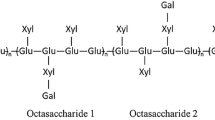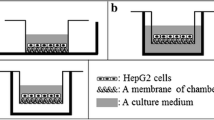Abstract
We developed a poly(ethylene glycol) (PEG) derivative with oleyl groups, so-called “cell adhesive”, for the promotion of human hepatocellular carcinoma HepG2 cell spheroids. Our approach was based on crosslinking of the cell membrane with a cell adhesive via a hydrophobic interaction. A cell adhesive, PEG derivative with hydrophobic oleyl groups at both ends was synthesized and characterized. HepG2 spheroids formed when the adhesive was added to cell suspensions. The size of the spheroids increased with time in culture. In addition, Ammonia elimination of HepG2 spheroid with cell adhesive was 3.4 times higher than that without cell adhesive. Furthermore, albumin secretion from HeG2 spheroids grown with the cell adhesive for 7 days was 3.3 times that from HepG2 spheroids grown without cell adhesive. Fluorescence microscopy showed greater albumin staining in spheroids grown with cell adhesive compared with spheroids grown without adhesive. This cell adhesive may be useful not only for single type of cells but also for multi types of cells to form artificial organs. This cell adhesive will be a key material for liver tissue engineering when it will apply to primary hepatocytes.






Similar content being viewed by others
References
Langer R, Vacanti JP. Tissue engineering. Science. 1993;260:920–6.
Griffith LG, Naughton G. Tissue engineering-current challenges and expanding opportunities. Science. 2002;295:1009–14.
Drury JL, Mooney DJ. Hydrogels for tissue engineering: scaffold design variables and applications. Biomaterials. 2003;24:4337–51.
Abbott A. Biology’s new dimension. Nature. 2003;424:870–2.
Service RF. Molecular scaffolding helps raise a crop of neurons. Science. 2003;302:46–7.
Seo SJ, Kim IY, Choi YJ, Akaike T, Cho CS. Enhanced liver functions of hepatocytes cocultured with NIH 3T3 in the alginate/galactosylated chitosan scaffold. Biomaterials. 2006;27:1487–95.
Kinoshita N, Echigo Y, Shinohara S, Gu Y, Miyazaki J, Inoue K, Imamura M. Regulation of cell proliferation using tissue engineering in MIN6 cells. Cell Transplant. 2001;10:473–7.
Nagaki M, Shidoji Y, Yamada Y, Sugiyama A, Tanaka M, Akaike T, Ohnishi H, Moriwaki H, Muto Y. Regulation of hepatic genes and liver transcription factors in rat hepatocytes by extracellular-matrix. Biochem Biophys Res Commun. 1995;210:38–43.
Martin Y, Vermette P. Bioreactors for tissue mass culture: design, characterization, and recent advances. Biomaterials. 2005;26:7481–503.
Brown LA, Arterburn LM, Miller AP, Cowger NL, Hartley SM, Andrews A, Silber PM, Li AP. Maintenance of liver functions in rat hepatocytes cultured as spheroids in a rotating wall vessel. In Vitro Cell Dev Biol Anim. 2003;39:13–20.
Nishikawa M, Ohgushi H, Tamai N, Osuga K, Uemura M, Yoshikawa H, Myoui A. The effect of simulated microgravity by three-dimensional clinostat on bone tissue engineering. Cell Transplant. 2005;14:829–35.
Yamauchi N, Yamada O, Takahashi T, Hashizume K. Spheroid formation of bovine endometrial stromal cells with non-adherent culture plate. J Reprod Develop. 2001;47:165–71.
Otsuka H, Hirano A, Nagasaki Y, Okano T, Horiike Y, Kataoka K. Two-dimensional multiarray formation of hepatocyte spheroid on a microfabricated PEG-brush surface. ChemBioChem. 2004;5:850–5.
Tamura T, Sakai Y, Nakazawa K. Two-dimensional microarray of HepG2 spheroids using collagen/polyethylene glycol micropatterned chip. J Mater Sci Mat Med. 2008;19:2071–7.
Ito M, Taguchi T. Enhanced insulin secretion of physically crosslinked pancreatic β-cells by using a poly(ethylene glycol) derivative with oleyl groups. Acta Biomater. 2009;5:2945–52.
Kato K, Umezawa K, Funeriu DP, Miyake M, Miyake J, Nagamune T. Immobilized culture of nonadherent cells on an oleyl poly(ethylene glycol) ether-modified surface. Biotechniques. 2003;35:1014–22.
Kato K, Itoh C, Yasukouchi T, Nagamune T. Rapid protein anchoring into the membranes of mammalian cells using oleyl chain and poly(ethylene glycol) derivatives. Biotechnol Prog. 2004;20:897–904.
Wang T, Leventis R, Silvius JR. Artificially lipid-anchored proteins can elicit clustering-induced intracellular signaling events in Jurkat T-lymphocytes. Independent of lipid Raft association. J Biol Chem. 2005;24:22839–46.
Miura S, Teramura Y, Iwata H. Encapsulation of islets with ultra-thin polyion complex membrane through poly(ethylene glycol)-phospholipids anchored to cell membrane. Biomaterials. 2006;27:5828–35.
Meier W, Hotz J, Günther-Ausborn S. Vesicle and cell networks: interconnecting cells by synthetic polymers. Langmuir. 1996;12:5028–32.
Boonyarattanakalin S, Athavankar S, Sun Q, Peterson BR. Synthesis of an artificial cell surface receptor that enables oligohistidine affinity tags to function as metal-dependent cell-penetrating peptides. J Am Chem Soc. 2006;128:386–7.
Mart RJ, Liem KP, Wang X, Webb SJ. The effect of receptor clustering on vesicle–vesicle adhesion. J Am Chem Soc. 2006;128:14462–3.
Menger FM, Zhang H. Self-adhesion among phospholipid vesicles. J Am Chem Soc. 2006;128:1414–5.
Yoshimoto N, Yoshimoto M, Yasuhara K, Shimanouchi T, Umakoshi H, Kuboi R. Evaluation of temperature and guanidine hydrochloride-induced protein-liposome interactions by using immobilized liposome chromatography. Biochem Eng J. 2006;29:174–81.
Thongborisute J, Takeuchi H, Yamamoto H, Kawashima Y. Properties of liposomes coated with hydrophobically modified chitosan in oral liposomal drug delivery. Pharmazie. 2006;61:106–11.
Teramura Y, Kaneda Y, Totani T, Iwata H. Behavior of synthetic polymers immobilized on a cell membrane. Biomaterials. 2008;29:1345–55.
Seo SJ, Kim IY, Choi YJ, Akaike T, Cho CS. Enhanced liver functions of hepatocytes cocultured with NIH 3T3 in the alginate/galactosylated chitosan scaffold. Biomaterials. 2006;27:1487–95.
Fukuda J, Khademhosseini A, Yeo Y, Yang X, Yeh J, Eng G, Blumling J, Wang CF, Kohane DS, Langer R. Micromolding of photocrosslinkable chitosan hydrogel for spheroid microarray and co-cultures. Biomaterials. 2006;27:5259–67.
Verma P, Verma V, Ray P, Ray AR. Formation and characterization of three dimensional human hepatocyte cell line spheroids on chitosan matrix for in vitro tissue engineering applications. In Vitro Cell Dev Biol Anim. 2007;43:328–37.
Verma P, Verma V, Ray P, Ray AR. Agar-gelatin hybrid sponge-induced three-dimensional in vitro ‘liver-like’ HepG2 spheroids for the evaluation of drug cytotoxicity. J Tissue Eng Regen Med. 2009;3:368–76.
Khalil M, Shariat-Panahi A, Tootle R, Ryder T, McCloskey P, Roberts E, Hodgson H, Selden C. Human hepatocyte cell lines proliferating as cohesive spheroid colonies in alginate markedly upregulate both synthetic and detoxicatory liver function. J Hepatol. 2001;297:68–77.
Liu J, Kuznetsova LA, Edwards GO, Xu J, Ma M, Purcell WM, Jackson SK, Coakley WT. Functional three-dimensional HepG2 aggregate cultures generated from an ultrasound trap: comparison with HepG2 spheroids. J Cell Biochem. 2007;102:1180–9.
Acknowledgments
We thank Ms. M. Morita of National Institute for Materials Science for technical support. This study was financially supported in part by the Ministry of Education, Culture, Sports, Science and Technology (MEXT) of Japan (Grant-in-Aid for Exploratory Research No. 21659074), the Japan Society for the Promotion of Science (JSPS) through the “Funding Program for World-Leading Innovative R&D on Science and Technology (FIRST Program),” initiated by the Council for Science and Technology Policy (CSTP), MANA and the World Premier International Research Center (WPI) Initiative on Materials Nanoarchitectonics, MEXT, Japan.
Author information
Authors and Affiliations
Corresponding author
Rights and permissions
About this article
Cite this article
Taguchi, T., Rao, Z., Ito, M. et al. Induced albumin secretion from HepG2 spheroids prepared using poly(ethylene glycol) derivative with oleyl groups. J Mater Sci: Mater Med 22, 2357 (2011). https://doi.org/10.1007/s10856-011-4414-4
Received:
Accepted:
Published:
DOI: https://doi.org/10.1007/s10856-011-4414-4




